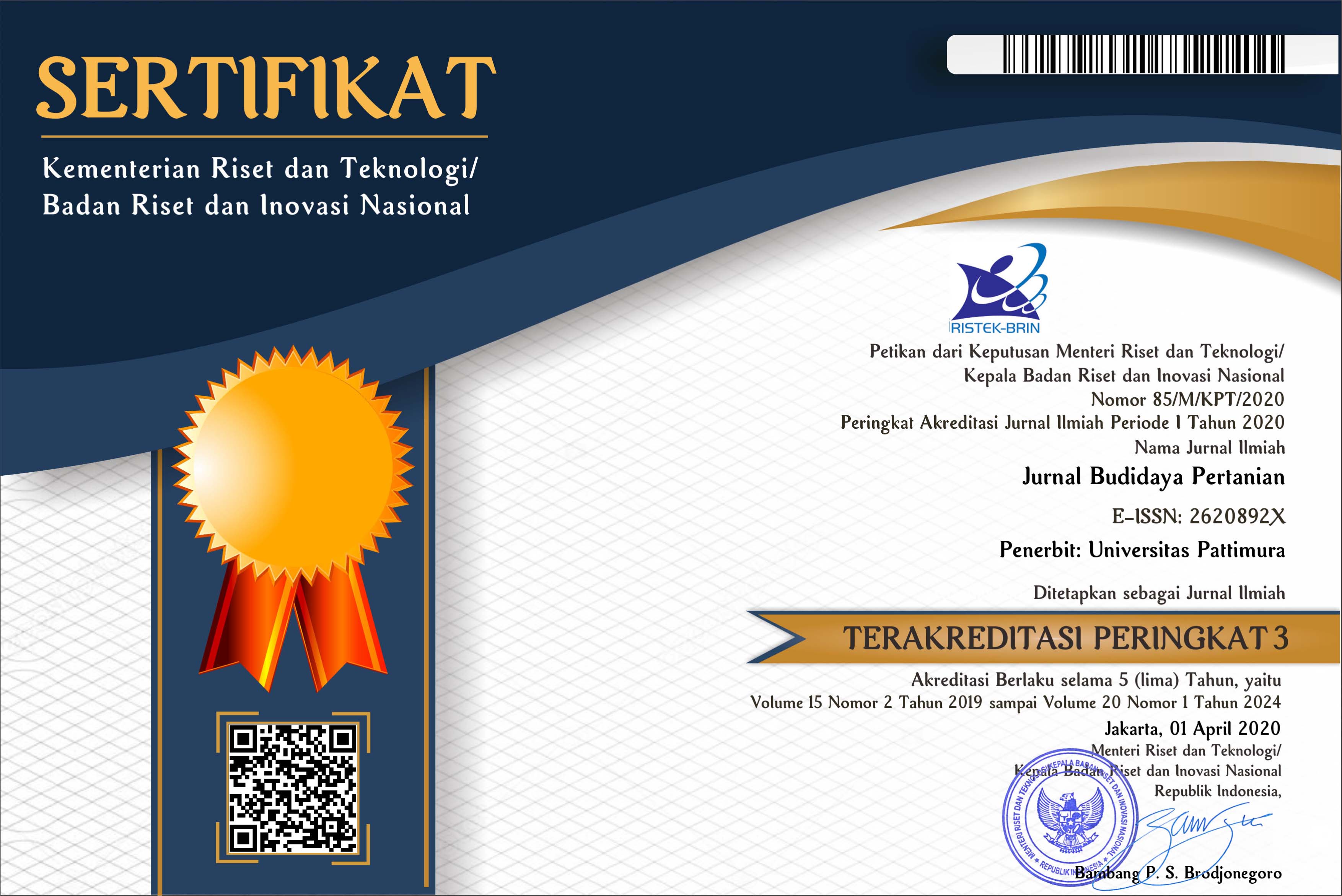Prospects of Azotobacter as a Biofertilizer in Saline Soils
Abstract
Climate change causes high waves on the seas that can accelerate the salinization of agricultural land located in coastal areas. Saline soil does not support plant growth because of the limitations of plant roots in absorbing water and nutrients, especially Nitrogen. Increasing salinization causes challenges in finding proper soil management methods, including nature-based solutions. A potential method to strengthen plant growth in saline areas is the introduction of biofertilizers containing nitrogen-fixing bacteria (NFB) that are resistant to salinity. This article aims to review the tolerance of nonsymbolic NFB Azotobacter to salinity and discuss the potential of this beneficial rhizobacterium for mitigating plant cultivation in saline land. The article was compiled through a literature study analyzing various relevant references from national and international journals in the last ten years. Analysis of the references shows that several soil Azotobacter strains are resistant to certain salt levels and have specific physiological characteristics when living in saline environments. Azotobacter induces plant tolerance to high salinity in the pot experiment. Therefore, Azotobacter inoculation becomes one of the alternatives to increase the growth of crops in saline soil.
Downloads
References
Abdiev, A., Khaitov, B., Toderich, K., & Park, W. (2019). Growth, nutrient uptake and yield parameters of chickpea (Cicer arietinum L.) enhance by Rhizobium and Azotobacter inoculations in saline soil. Journal of Plant Nutrition. 42, (20), 2703–2714. https://doi.org/10.1080/01904167.2019.1655038
Akhter, M.S., Hossain, S. J., & Datta, R.K. (2012). Isolation and characterization of salinity tolerant Azotobacter sp. Greener Journal of Biological Science, 2(3), 43-51. https://doi.org/10.15580/GJBS.2012.3.110312207
Awedat, A.M. Zhu, Y., Bennett, J.M., Raine, S.R. (2021). The impact of clay dispersion and migration on soil hydraulic conductivity and pore networks, Geoderma, 404, 15, 115297. https://doi.org/10.1016/j.geoderma.2021.115297
Banerjee, A., Supakar, S., & Banerjee, R. (2014). Melanin from the nitrogen-fixing bacterium Azotobacter chroococcum: a spectroscopic characterization. PLoS One, 9(1), e84574. https://doi.org/10.1371/journal.pone.0084574
Barron, S., Mus, F., Peters, J.W. (2024). Nitrogen-Fixing Gamma Proteobacteria Azotobacter vinelandii—A Blueprint for nitrogen-fixing plants. Microorganisms. 12(10), 2087. https://doi.org/10.3390/microorganisms12102087
Bhagat, N., Raghav, M., Dubey, S., Be, N. 2021. Bacterial Exopolysaccharides: Insight into their role in plant abiotic stress tolerance. J Microbiol Biotechnol. 2021 Jun 21;31(8):1045–1059. doi: 10.4014/jmb.2105.05009
Bhavna, B., Shruti, S., and Sangeeta, S. 2019. Isolation and characterization of halotolerant Azotobacter species from different coastal soils of South Gujarat Region. International Journal of Pharmacy and Biological Sciences-IJPBSTM (2019) 9 (2): 774-779
Bjelić, D.Đ., Marinković, J. B., Tintor, B.B., Tančić, S. L., et al. (2015). Screening of Azotobacter isolates for PGP properties and antifungal activity. Zbornik Matice Srpske Za Prirodne Nauke, 129(1), 65–72. https:// doi.org/10.2298/ZMSPN1529065B
Çam, S., Küçük, Ç., Cevheri, C. 2022. The effect of salinity-resistant biofilm-forming Azotobacter spp. on salt tolerance in maize growth. Zemdirbyste-Agriculture, 109(4), 349–358. DOI 10.13080/z-a.2022.109.045
Chennappa G., Naik M.K., Adkar-Purushothama C.R., Amaresh Y.S. and Sreenivasa M.Y.; (2016). PGP potential abiotic stress tolerance and antifungal activity of Azotobacter strains from paddy soil. Indian Journal of Experimental Biology 54; 322-331
Dar, S.A., Bhat, R.A., Dervash, M.A., Dar, Z.A. & Dar, G.H. (2021). Azotobacter as Biofertilizer for Sustainable Soil and Plant Health Under Saline Environmental Conditions. In Hakeem, K.R., et al. (eds.), Microbiota and Biofertilizers, 231-254. https://10.1007/978-3-030-48771-3_14
Erfandi, D. & Rachman, A. (2011). Identification of soil salinity due to seawater intrusion on rice field in the northern coast of Indramayu, West Java. Journal of Tropical Soils, 16(2): 115-121. https:// doi.org/10.5400/jts.2011.16.2.115
FAO. (2021). Global Map of Salt Affected Soils Version 1.0 (2021). https://www.fao.org/soils-portal/data-hub/soil-maps-and-databases/global-map-of-salt-affected-soils/en/ [21/02/2025].
Geddie J.L., Sutherland I.W. 1993. Uptake of metals by bacterial polysaccharides. J. Appl. Bacteriol., 74:467–472. doi: 10.1111/j.1365-2672.1993.tb05155.x.
Grundmann, J., Al-Khatri, A., & Schütze, N. (2016). Managing saltwater intrusion in coastal arid regions and its societal implications for agriculture. Proceedings of the International Association of Hydrological Sciences, 373, 31–35. https:// doi.org/10.5194/piahs-373-31-2016
Hammam, A.A. & Mohamed, E.S. (2020). Mapping soil salinity in the East Nile Delta using several methodological approaches of salinity assessment. The Egyptian Journal of Remote Sensing and Space Science, 23(2), 125-131. https:// doi.org/10.1016/j.ejrs.2018.11.002
Haryono, M. N., Syahbuddin, H. & Sarwani, M. (2012). Lahan Rawa: Penelitian dan Pengembangan. Badan Penelitian dan Pengembangan Pertanian, Jakarta, 103 hal.
Hasrianda, E.F., Fefirenta, A.D., Gunawan, I., & Davis, O.M.M. (2024). Management of saline stress in rice paddy farming: A study from Tirtayasa Region, Serang Regency, Banten Province, Indonesia. Pangan, 33(1), 31 - 46.
Hindersah, R., R., Osok, O, Mulyani. (2017). Proliferation and exopolysaccharide production of Azotobacter in the presence of mercury. Biodiversity, 8(1), 21–26.
Hindersah, R. Kalay, A.M., Talahaturuson, A., & Lakburlawal, Y. (2018). Nitrogen fixing bacteria Azotobacter as biofertilizer and biocontrol in long bean. Agric, 30(1), 25-32. https://doi.org/10.24246/agric.2018.v30.i1.p25-32
Hindersah, R., Suryatmana, P., Setiawati, M.R., Fitriatin, B.N., Nurbaity, A. & Simarmata, T. (2019). Salinity resistance of Azotobacter isolated from saline soil in West Java. In Sayyed R.Z et al. (eds). Plant Growth Promoting Rhizobacteria: Prospects For Sustainable Agriculture, pp 323–334. https:// doi.org/10.1007/978-981-13-6790-8_25
Hindersah, R., Kamaluddin, N.N., Samanta, S., Banerjee, S., Sarkar, S. (2020). Role and perspective of Azotobacter in crops production. Sains Tanah J. Soil Science and Agroclimatology, 17(2): 170-179. http://dx.doi.org/10.20961/stjssa.v17i2.45130
Hindersah, R., Subardja, V.O., Suryatmana, P., & Sudirja, R. (2024). Properties of Azotobacter as biofertilizer and biocontrol of Fusarium. Agrologia, 13(1),17-23. https://doi.org/10.30598/agrologia.v13i1.12761
Hui, R., Tan, H., Li, X., & Wang, B. (2022). Variation of soil physical-chemical characteristics in salt-affected soil in the Qarhan Salt Lake, Qaidam Basin. Journal of Arid Land, 14, 341–355. https:// doi.org/10.1007/s40333-022-0091-z
Igiri BE, SIR Okoduwa, GO Idoko, EP Akabuogu, AO Adeyi, IK Ejiogu. 2018. Toxicity and bioremediation of heavy metals contaminated ecosystem from tannery wastewater: a review. J Toxic, Vol 2018, Article 2568038, pp 16
Ingrisano, R., Tosato, E., Trost, P., Gurrieri, L., & Sparla, F. (2023). Proline, cysteine and branched-chain amino acids in abiotic stress response of land plants and microalgae. Plants, 12, 3410. https://doi.org/10.3390/plants12193410
Kakar, Z.H., Rasheed, R., Rashid, A., & Akhter, S. (2023). Criteria for assessing and ensuring trustworthiness in qualitative research. IJBR, 4(2), 150-173. http://111.68.103.26//journals/index.php/ijbr/article/view/7358.
Kumar, P., Thakur, S., Dhingra, G. K., Singh, A., et al. (2018). Inoculation of siderophore producing rhizobacteria and their consortium for growth enhancement of wheat plant. Biocatalysis and Agricultural Biotechnology, 15(1), 264–269. https:// doi.org/10.1016/j.bcab.2018.06.019
Latef, A.A.H.A, Omer, A.M., Badawy, A.A., Osman, M.S., Ragaey, M.M. (2021). Strategy of salt tolerance and interactive impact of Azotobacter chroococcum and/or Alcaligenes faecalis inoculation on canola (Brassica napus L.) plants grown in saline soil. Plants (Basel), 10(1), https:// doi.org/110.10.3390/plants10010110
Li, S., Wang, C., Huang, H., Zhao, L., Cao, J., Wang, B., & Ding, H. (2024). Vermicompost and Azotobacter chroococcum increase nitrogen retention in saline-alkali soil and nitrogen utilization of maize. Applied Soil Ecology, 201,105512. https://doi.org/10.1016/j.apsoil.2024.105512
Massahi, S., Naderi, D., & Pessarakli, M. (2018). Studying the effect of two biological fertilizers on salt tolerance of tall fescue (Festuca arundinaceae schreb.). Journal of Plant Nutrition, 41(17), 1-12. https:// doi.org/10.1080/01904167.2018.1500587
McRose. D.L., Baars, O., Morel, F.M.M., Kraepiel, A.M.L. 2017. Siderophore production in Azotobacter vinelandii in response to Fe-, Mo- and V-limitation. Environ Microbiol . 19(9),3595-3605. doi: 10.1111/1462-2920.13857.
Mindari, W., Sasongko, P. E., & Kusuma, Z., Syekhfani. (2015). Characteristics of saline soil and effect of fertilizer application to rice yield. International Journal of Agronomy and Agricultural Research, 6(1), 7–15.
Muhammad, M., Waheed, A., Wahab, A., Majeed, M., Nazim, M., Liu, Y-H., Li, L., Li, W-J. Li. (2023). Soil salinity and drought tolerance: An evaluation of plant growth, productivity, microbial diversity, and amelioration strategies. Plant Stress, 11, 100319. https://doi.org/10.1016/j.stress.2023.100319
Mukhopadhyay, R., Sarkar, B., Jat, H.S., Sharma, P.C., & Bolan, N.S. (2021). Soil salinity under climate change: Challenges for sustainable agriculture and food security. Journal of Environmental Management, 280, 111736. https:// doi.org/10.1016/j.jenvman.2020.111736
Ofoe R, Thomas RH, Asiedu SK, Wang-Pruski G, Fofana B and Abbey L (2023) Aluminum in plant: Benefits, toxicity and tolerance mechanisms. Front. Plant Sci. 13:1085998. doi: 10.3389/fpls.2022.1085998
Omer, A. M., Emara, H. M., Zaghloul, R. A., Abdel-Monem, M. O., et al. (2016). Potential of Azotobacter Salinestris as plant growth-promoting rhizobacteria under saline stress conditions. Research Journal of Pharmaceutical, Biological and Chemical Sciences, 7(6), 2572-2583.
Page, W. J., & Shivprasad, S. (1991). Azotobacter salinestris sp. nov., a sodium-dependent, microaerophilic, and aeroadaptive nitrogen-fixing bacterium. International Journal of Systematic Bacteriology, 41(3), 369–376. https:// doi.org/10.1099/00207713-41-3-369
Paul, S., Bandeppa, C., Aggarwal, J.K., Thakur, M., Singh, R., et al. (2014). Effect of salt on growth and plant growth promoting activities of Azotobacter chroococcum isolated from saline soils. Environment & Ecology, 32(4), 1255-1259.
Purwaningrahayu, R.D & Taufiq, A. (2018). Pemulsaan dan ameliorasi tanah salin untuk pertumbuhan dan hasil kedelai. Jurnal Agronomi Indonesia, 46(2),182-188. https://doi.org/10.24831/jai.v46i2.16517
Ravikumar, S., Kathiresan, K., Ignatiammal, S.T.M., et al. (2004). Nitrogen-fixing azotobacters from mangrove habitat and their utility as marine biofertilizers. Journal of Experimental Marine Biology and Ecology, 312(1), 5–17. https:// doi.org/10.1016/j.jembe.2004.05.020
S. Viscardi, V. Ventorino, P. Duran, A. Maggio, S. De Pascale, M.L. Mora, O. Pepe. 2016. Assessment of plant growth promoting activities and abiotic stress tolerance of Azotobacter chroococcum strains for a potential use in sustainable agriculture. Journal of Soil Science and Plant Nutrition, 2016, 16 (3), 848-863
Sivapriya, S.L., & Priya, P.R. (2017). Selection of hyper exopolysaccharide producing and cyst forming Azotobacter isolates for better survival under stress conditions. International Journal of Current Microbiology and Applied Sciences, 6(6), 2310-2320. https://doi.org/10.20546/ijcmas.2017.606.274
Subardja, V.O., Hindersah, R., Sudirja, R., Suryatmana, P. (2022). Effect of Azotobacter sp. inoculation on sweet potatoes (Ipomoea batatas L.) yield in lead-contaminated soil, Bulgarian Journal of Agricultural Science, 28 (2) 2022, 229–237.
Sutono, S. (2014). Pemulihan lahan sawah terdegradasi akibat intrusi air laut untuk mendukung peningkatan kualitas lahan. Laporan akhir Penelitian, Balai Penelitian Tanah. Bogor.
T.H. Wang, Y.T. Tchan, A.M.M. Zeman, I.R. Kennedy, 1993. Presence of sodium dependent azotobacter in Australia (New South Wales), Soil Biology and Biochemistry, 25(5), 637-639, https://doi.org/10.1016/0038-0717(93)90205-P.
T.H. Wilson, P.Z. Ding. 2001. Sodium-substrate cotransport in bacteria. Biochimica et Biophysica Acta (BBA) – Bioenergetics. 1505(1), 121-130. https://doi.org/10.1016/S0005-2728(00)00282-6
Tarolli, P., Luo, J., Park, E., Barcaccia, G., & Masin, R. (2024). Soil salinization in agriculture: Mitigation and adaptation strategies combining nature-based solutions and bioengineering. Science, 27(2), 108830. https://doi.org/10.1016/j.isci.2024.108830
Temmerman, S., Meire, P., Bouma, T.J., Herman, P.M.J., Ysebaert, T., De Vriend, H.J. (2013). Ecosystem-based coastal defense in the face of global change. Nature, 504, 79-83. https://doi.org/10.1038/nature12859
Van Oosten, M.J., Di Stasio, E., Cirillo, V., Silletti, S., Ventorino, V. Pepe, O., et al. 2018. Root inoculation with Azotobacter chroococcum 76A enhances tomato plants adaptation to salt stress under low N conditions. BMC Plant Biology. 20(18), 205. doi: doi: 10.1186/s12870-018-1411-5
Vauclare, P., Natali, F., Kleman, J. P., Zaccai, G., et al. (2020). Surviving salt fluctuations: stress and recovery in Halobacterium salinarum, an extreme halophilic Archaeon. Scientific Reports, 10, 3298. https://doi.org/10.1038/s41598-020-59681-1
Yaghoubian, I., Ghassemi, S., Nazari, M., Raei, Y., & Smith, D. (2021). Response of physiological traits, antioxidant enzymes and nutrient uptake if soybean to Azotobacter chroococcum and zinc sulfate under salinity. South African Journal of Botany, 143, 42-51. https://doi.org/10.1016/j.sajb.2021.07.037
Yan, N., Marschner, P., Cao, W., Zuo, C., et al. (2015). Influence of salinity and water content on soil microorganisms. International Soil and Water Conservation Research, 3(4), 316–323. https://doi.org/10.1016/j.iswcr.2015.11.003
Zhu, H. Y., Gan, B., Liang, F., Zhou, B.B., Sun, Y., Duan, M. L., Bai, Y. H. (2016). Effect of soil salinity on nitrogen transformation in soil with nitrogen fertilizer application. Applied Ecology And Environmental Research, 21(6), 5625-5642. https://doi.org/10.15666/aeer/2106_56255642
Zulaika, E, and Prasidya, D.A (2015). Viabilitas Azotobacter A1a, A3, dan A9 pada medium yang terpapar logam cadmium (Cd). Jurnal Sains dan Seni, 4 (2), E-91.
Copyright (c) 2025 Reginawanti Hindersah, Betty N Fitriatin, Mieke R Setiawati, Aliya Z Adawiyah

This work is licensed under a Creative Commons Attribution-ShareAlike 4.0 International License.

 Accreditation is valid for 5 years, starting from Volume 15 Issues 2 December 2019 up to Volume 20 Issue 1 June 2024.
Accreditation is valid for 5 years, starting from Volume 15 Issues 2 December 2019 up to Volume 20 Issue 1 June 2024.






